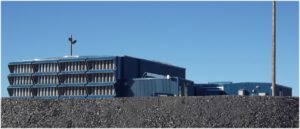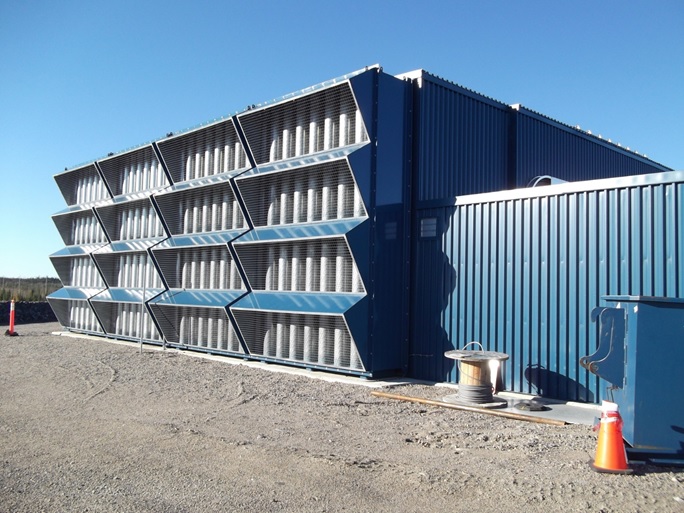In Canada and some other countries with Arctic mines like Russia, as well as some high-altitude mines, the cold ambient surface temperatures require mines to use air heating. It is not for underground comfort – it is primarily to prevent shaft freeze up including utilities such as water that are entering the mine via the shaft. This is in contrast to cooling deep mines which is done for both operator comfort and of course safety. Howden supplies both heating and cooling solutions – and a number of mines actually require both – heating for the upper parts of the shaft and cooling for the deep levels.
Peter Terkovics is Sales Director at Howden company ACI based in Concord, Ontario and is a mechanical engineer with decades of experience in mine heating, cooling and ventilation. He told IM: “Mines are heated in a multitude of ways, one of which is direct firing where burners are mounted within the air stream that is being directed underground. In most Canadian mines that are accessible by road, the fuel used for mine air heating tends to be either propane or natural gas due to its ease of transport, (pipeline where available or road), and their relatively clean burning properties. Diesel or oil firing is used mainly in parts of Arctic Canada that are not road accessible as well as in Russia.”
He adds: “Another reason besides transportation issues associated with delivering fuel to site that results in diesel or fuel oil being used is that it is being transported to these sites in any case to service the underground mobile fleet, boilers, generators etc. But as diesel burners do not burn very clean they are indirectly fired, whereby the products of combustion enter a heat exchanger that transfers heat into the airstream entering the mine, before the products of combustion (exhaust gases) are expelled via a stack. Another method of heating mine air includes the implementation of electric elements, however, this is limited by the cost of power local to the mine. Finally, there is thermal heat recovery, taking waste heat from a boiler or compressors for example and passing it through a heat exchanger that is mounted in the mine air stream. Even hot water resulting from natural, underground geothermal heat transfer can be brought to the surface for shaft heating.”

A specific regulation-related issue has arisen in several Canadian provinces with regard to mine heating and ultra low emissions levels associated with direct firing – the main heating method used in North America due to its high efficiency and the availability of natural gas and propane. In mining and in relation to direct fired mine air heating, CO is the gas traditionally regulated and closely monitored, with <5 ppm as a limit set by NC and CSA. Terkovics adds: “NO2 specifically has not been flagged up as an issue. It is one of the constituents of NOX and has come up in suggested limits set by the American Conference of Governmental Industrial Hygienists (ACGIH) and has started to show up into legislation related to exposure limits in mines – they require an extremely low NO2 limit which is being adopted in Manitoba, BC, Nova Scotia and Newfoundland & Labrador. NO2 in small amounts is more of an airways irritant and only affects lung function in high concentrations. The generally accepted threshold level has previously been 3 ppm TWA, however, in the provinces listed, it is now 0.2 ppm – which is 15 times lower than it was in the past. It is not yet clear if it will be mandated for greenfield mines only or also for all existing mines. What is clear is that these levels are extremely difficult to meet.”
Howden does have a solution in the form of its Ultra Low Emission Heaters cold flame technology that provides uniform temperature differential while maintaining NO2 emission under 0.2 ppm, significantly reducing miner exposure. It is the only system available that can be incorporated into existing heating plants and footprints via a seamless integration and that ensures temperature uniformity through the mine fan. The temperature uniformity associated with the Howden solution reduces fan blade stress and fatigue and in so doing, it improves fan reliability and eliminates the risk of catastrophic fan failure that can be caused by stratification associated with localised hot air injection. It involves removing the existing burner and control system and replacing them with burners and proprietary controls that are inherently designed to produce lower NOX (therefore lower NO2) levels by using lower flame temperatures. This is achieved using premixing of the fuel in a mixing box that is more precisely controlling the feed of fuel and air into the burner. The system has not yet been installed in a full scale mine heating plant, but has been proven in smaller scale. It is ready for customer use once operations begin to be affected by the new regulations. It will certainly affect new plants, but also any existing plants that need to increase airflow or be expanded as they need to be recertified.
Howden says its solution provides the lowest direct-fired, mine air heating emissions available; which can be seamlessly integrated into most existing mine ventilation systems plus provides uniform heat distribution. It also protects the existing mine fan and associated devices from potential failure caused by heat stratification, maximises safety and efficiency, while reducing potential downtime and the need for additional footprint and retrofitting.












